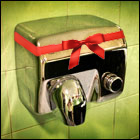|
Motronic posted:You get to towed elsewhere because the experience of the place you are dealing with tops out at "oil changes". Easy to say. This is the largest, most reputable GM dealer in the area and I have a professional acquaintance with the service manager. All the shops in my own dealer group are import brands, and most of my guys donít want to look at domestic trucks. Iíve been in the business in my area for the past 15 years. Thereís a real dearth of quality shops here so Iím at a loss where Iíd get a second opinion.
|
|
|
|

|
| # ? May 14, 2024 06:28 |
|
Guess your acquaintances/"reputation" are more important than getting your car fixed. That's a decision only you can make. I can't imagine this place you live in where there are only dealerships and no decent independent shops. Also, this is not anything most people would consider to be an endorsement for a good repair shop: mr.belowaverage posted:This is the largest, most reputable GM dealer in the area
|
|
|
|
spankmeister posted:Get longer wires Well poo poo, that's probably the easiest end to this! StormDrain posted:Yah get longer wires. Considering it's a trailer here are two new suggestions. 1. Park the truck closer to the tires. 2. Use the aux power from the trailer connection. Either if there's a power point on the trailer or buy a seven pin connector and wire it to a little connector for the air. That's a lot closer to the trailer tires. I really like the 7 pin connector idea; I think that'll make it easier to work with rather than having a 25ft power cord. Thanks to both of you for your input!
|
|
|
|
mr.belowaverage posted:Easy to say. This is the largest, most reputable GM dealer in the area and I have a professional acquaintance with the service manager. If you have a good working relationship with the service manager, and you show him/her what you just told us, they should go through the roof.
|
|
|
|
PainterofCrap posted:If you have a good working relationship with the service manager, and you show him/her what you just told us, they should go through the roof. Iíll have to test this theory. I genuinely find quality work to be the rarest thing. Like literally impossible to find as a customer, and just as hard to cultivate and enforce as a manager myself.
|
|
|
|
Hi friends, I hope this is the right thread for a stupid car question. A buddy asked what I thought might be under this cover, and I know about cars a bit but Iíve got no clue. Any thoughts? 
|
|
|
|
If I had to guess itís a sixth gen Chevy Monte Carlo Odd choice of car to keep around though ( I donít think itís an SS) and Iím not sure it came with steel wheels. The trunk shape is distinctive though and the front bumper moulding looks like it could match.
|
|
|
|
^^^^^ It looks like a 4 door to me. Some late 90s, early 2000s pile of poo poo.
|
|
|
|
I donít see the rear doors on it. That line is for the car cover.
|
|
|
|
Yup, my bad.
|
|
|
|
wesleywillis posted:Some late 90s, early 2000s pile of poo poo. I mean you werenít wrong. I imagine the owner as a 40 something year old man that drinks Busch light, wears sleeveless shirts with eagles and American flags on them, blue lens sunglasses and semi worships dale earnhardt and Richard petty. Heís totally gonna restore that piece of poo poo one day. Really he will
|
|
|
|
Crease / angle change in the door sheetmetal says "mid-90s Benz" but the monochrome bumper cover says "Camry"
|
|
|
|
Ya'll act like you ain't never seen a late 90s Toyota Tercel before. god, why couldn't i get a brain that's good for useful poo poo. Grocery shopping without a panic attack? naw, photographic memory of shitboxes. Powershift fucked around with this message at 06:52 on Jan 8, 2022 |
|
|
|
the milk machine posted:Hi friends, I hope this is the right thread for a stupid car question. my guess is a first gen Neon
|
|
|
|
Its got 4 bolt wheels so that should narrow it down to only like 21436147621 cars.
|
|
|
|
wesleywillis posted:Its got 4 bolt wheels so that should narrow it down to only like 21436147621 cars. It's a Tercel.   note the bumper rub strips, sharp lower body line, side rub strip peeking out below the cover, sharp trunk lid, wind mint metallic paint.
|
|
|
|
wow, a tercel sure looks pretty close. maybe there's a lovely spoiler on it or something? this is near durham, nc, so the perfect place to put some weird heap under a car cover. thank you folks
|
|
|
|
Powershift posted:It's a Tercel. And there it is! I am of high hopes that someone is storing a car for someone on deployment.
|
|
|
|
PainterofCrap posted:And there it is! I think that car's been thought about more in the last week in this thread than it has for anyone in real life for years.
|
|
|
|
Tercels were just such honest cars. I miss that level of cheap utility being available to the masses.
|
|
|
|
VelociBacon posted:Maybe this time it's the o2 sensor after the cat, if you have two. It is the one after the cat, although it was last time as well. Out of interest, why does before/after cat have a different effect?
|
|
|
|
simplefish posted:It is the one after the cat, although it was last time as well. I could be wrong and someone will correct me but the o2 sensor before the cat is used in open loop fuel trim adjustments or something like that.
|
|
|
|
simplefish posted:It is the one after the cat, although it was last time as well. I believe the pre-cat O2 data is used to alter fuel delivery, while tbe post-cat O2 data is only used to trip a code if things look wrong.
|
|
|
|
simplefish posted:It is the one after the cat, although it was last time as well. Pre-cat is what your ECU uses to adjust fuel trims (in CLOSED loop), post cat O2 is looking for a differential from the front O2 reading for no reason other than to detect if the cat is working. It has no impact on how anything runs and is purely an emissions tattletale.
|
|
|
|
.
melon cat fucked around with this message at 06:27 on Jan 10, 2024 |
|
|
|
Motronic posted:Pre-cat is what your ECU uses to adjust fuel trims (in CLOSED loop), post cat O2 is looking for a differential from the front O2 reading for no reason other than to detect if the cat is working. It has no impact on how anything runs and is purely an emissions tattletale. The post sensor does affect how the engine runs. O2 sensor engineer here (I wear more than one hat!) Yes, the pre sensor is used for closed loop short-term fuel trim. It is responsible for making sure your car operates near stoich, the ideal operating range (lean burn engines still aren't a thing, unfortunately). There are other things it's used for like cylinder imbalance detection (and control for some OEMs), etc. The post sensor doesn't necessarily look for a differential; different OEMs use different strategies but in general, in additional to monitoring catalyst efficiency, it DOES modify the long-term fuel trim which will affect how your car runs. If your post sensor is stuck lean, for example, your long-term fuel trim will go rich and your fuel economy will suffer. There's more to it but the specifics depend a lot lot lot on which OEM you're talking to but the general concept is pretty much always the same. (Incidentally, happy to answer any questions about O2 sensors. Just remember, I'm an engineer, not a mechanic.) totalnewbie fucked around with this message at 02:25 on Jan 10, 2022 |
|
|
|
totalnewbie posted:The post sensor does affect how the engine runs. O2 sensor engineer here (I wear more than one hat!) Ok, heres one: How the poo poo do they actually measure o2? And how does it know good vs bad? Does it just send a reading back to the ECU and the ECU decides? How does engine rpm/load effect what the readings are and does that change if someone puts in a highflow exhaust and/or cat? Is a specific o2 sensor calibrated, or otherwise chosen based on engine displacement, exhaust diameter etc, or is a part just chosen and then the ECU settings are just calibrated based on what signal *should* be recieved from the sensor when everything is working properly?
|
|
|
|
There's two (three) types of O2 sensors these days. I'll just stick to the two main ones, switching and wide range. How they work They both operate by the same principle - the elements are made of yttria stabilized zirconia. Put very simply, an yttrium atom replaces a zirconium atom in the crystal structure and the end result is that O2- ions (not a whole oxygen molecule) is able to move through the interstitials (atomic-level gaps in the crystal structure). Let's talk about electricity briefly. What is it? One way to (imperfectly) think of it is the movement of charge from A to B. Usually, this is done by electrons through metal. Sometimes, it can get weird like in semiconductors where could also be the absence of an electron that is the charge carrier (a hole). But here, in the O2 sensor, the charge carrier is an O2- ion, meaning it's a single oxygen atom with a negative 2 charge. So, you've got an element that can conduct electricity via oxygen ions but you need some reason for the ions to actually move through the element. That's how an O2 sensor works. You always have a reference side of the element (it's exposed to air; it's why some O2 sensors have a filter, so air can get in and out) and the sensing side which is exposed to the exhaust. When there is a difference in the partial pressure of oxygen between the exhaust and air, oxygen ions now want to travel across that element to reduce that difference. This is governed by the https://en.wikipedia.org/wiki/Nernst_equation. Basically, the greater the difference between partial pressures, the larger the EMF (i.e. voltage). If you look at the Nernst equation, you'll notice it's a log function with respect to the ratio of ppO2 between exhaust and air. When lambda swings through 1 between rich and lean, you have large orders of magnitude changes in the amount of O2 in the exhaust. This shows up in the Nernst equation as a large shift in EMF around lambda 1 - the classic Z-curve. So for a switching sensor (and it's more complicated and OEMs do all sorts of things with it but there's no real need to get into it), it basically tells the ECU when it's rich or lean. The ECU then adjusts fueling to compensate but it can't adjust it finely enough (nor is combustion ever stable enough) to hit lambda 1 completely, so it swings between rich and lean. Hence, switching sensor. Now, a widerange sensor is very similar, except that it's two switching sensors put together. It's two zirconia cells put together with a small space in between. Exhaust enters that space and one cell responds to the change in amount of O2 in the exhaust. An ASIC in the ECU, though, will now apply a voltage to the other cell to try to force the first cell back to 450 mV (lambda 1). The amount of current flowing through the second cell is measured (well, calculated) and the magnitude of how much current flows through the second cell tells you how much work was needed to push the first cell back to stoich. This is how we are now able to tell with much greater accuracy how far away from stoich you are. The third kind is a wide-range sensor that uses a single cell instead of two; Denso makes these but they're not widely used (Toyota uses them as the rear O2). There is obviously a lot more to it, especially the widerange sensor, but it can quickly devolve into a lot of small details that start to depend a lot on the particular ASIC used, etc. As an aside, this is also how an NOx sensor works - there's a third chamber where NOx enters that catalyzes the NOx and NOx detection is done via that signal. It's very, very small. OBD Most sensors set either a heater code - usually open circuit due to broken wire - or sensor stuck lean. The latter is detected a couple different ways, the first of which is that the vehicle is calibrated with a threshhold voltage above or below which it will set a code. So if your sensor gets an open wire, voltage drops below that threshhold and you set a stuck lean code or something to that effect. There are also intrusive tests that are performed during driving to check sensor function but it's rare for the sensor to fail in that way. It's almost always some sort of physical damage which means it's almost always heater open circuit or stuck lean (i.e. element open circuit). Engine condition Engine condition generally does not affect O2 sensor. That said, the sensors do have temperature and (for widerange) pressure dependencies but those are dealt with during vehicle calibration (adjust heater control for temperature and pressure dependency can depend on the exhaust layout - possibly it's just never large enough to matter). OEMs are required to monitor cylinder imbalance which can be difficult at high RPMs with many cylinders but typically they have split exhaust so it's not that bad. If your sensor response is too slow, you will have problems but that's not an issue anymore. Sensor choice/calibration There's a few things that go into it, but basically, they are what they are and OEMs take what they get and they calibrate around it. Especially for switching sensors, they can ask for, and sometimes receive, slight variations on the elements for their particular calibration strategies but they are very minor differences (to anyone that's not an engineer that's directly involved with calibration). When it comes to widerange sensors, it can be a little more difficult because ASIC hardware in the ECU is necessary and not every ASIC is compatible with every widerange O2 sensor (basically delineated by manufacturers). Very similar to switching sensors, OEMs calibrate the vehicles to what the expected sensor behavior is. Because of the involvement of the ASIC, widerange sensor elements are always the same (within a product generation for the most part) because if you change the element then the ASIC may no longer be appropriate. A lot of work goes into making sure sensors are compatible with ASICs because if not, and sometimes very subtly so, it can lead to big problems and lots of finger pointing and headaches and early morning meetings (it can get extremely specific and extremely detailed. I'd love to share because it's all very interesting but I edit: oops, it CAN be hole conduction in semiconductors; it could also be "normal" electron conduction totalnewbie fucked around with this message at 06:19 on Jan 10, 2022 |
|
|
|
totalnewbie posted:There's two (three) types of O2 sensors these days. I'll just stick to the two main ones, switching and wide range.  (USER WAS PUT ON PROBATION FOR THIS POST) (USER WAS PUT ON PROBATION FOR THIS POST)
|
|
|
|
Brevity is the soul of wit, which tells you all you need to know about me.
|
|
|
|
totalnewbie posted:There's two (three) types of O2 sensors these days. I'll just stick to the two main ones, switching and wide range. I wish I could bookmark posts or something for when I have an o2 sensor issue and forget this.
|
|
|
|
totalnewbie posted:Brevity is the soul of wit, which tells you all you need to know about me. Rather see one of your posts than 100 lovely replies. Annnyway.... So you mentioned there are three types of O2 sensors. You also mentioned switched as one type - is that what is otherwise called a narrowband O2?
|
|
|
|
totalnewbie posted:Sensor Well I read it all and learned and thought it was cool, thanks!
|
|
|
|
Is it just me, or is right now a really bad time to be thinking about buying a new car? Went to a few different dealerships this past Saturday and it was pitiful how few cars were on each lot. Even more weird is how the website for each dealership would list cars as if they are in stock and be all "oh, the website stock listings are shared between Kennesaw, Newnan and Columbus, GA but we aren't going to tell anybody that anywhere on the website" (to say nothing of all of the "In Transit" listings that have been "In Transit" since before Thanksgiving). Yeah, I know there are shipping problems but keep your websites up to date. The absolute weirdest thing was having the salesperson I spoke with at the Hyundai lot in Kennesaw tell me that they want everybody to go through the Online financing application for a vehicle (and all of the pricing on trade-ins/etc.) and put $1,000 down before even test-driving whatever the vehicle happens to be (the $1,000 is supposedly refundable, but gently caress that). I get wanting to cut back on people wandering around lots during a pandemic, that's why I made test drive appointments for different vehicles (that sold before I got to test drive them at not-Hyundai lots), but gently caress that particular Hyundai lot.
|
|
|
|
biracial bear for uncut posted:Is it just me, or is right now a really bad time to be thinking about buying a new car? Um, it's a really bad time to be buying a car? It's been widely reported for two years, now. Supply is low, parts to build cars are back ordered, shipping is a mess, manufacturing is dealing with their own supply and employee issues, demand is through the roof, etc. Wait if you can.
|
|
|
|
I see we've got ourselves a time traveller from early 2020.
|
|
|
|
Uthor posted:Um, it's a really bad time to be buying a car? It's been widely reported for two years, now. Supply is low, parts to build cars are back ordered, shipping is a mess, manufacturing is dealing with their own supply and employee issues, demand is through the roof, etc. Wait if you can. That would be why I went to this specific thread to ask a question about something I only pay attention to every however many years between buying a car and running it into the ground (last bought a car in 2016, before that in 2012, etc.; usually don't start looking until I clear 200k miles but since the pandemic started I've been putting it off).
|
|
|
|
If you're buying new, check out the Costco auto buying program. Some people in the GBS Costco thread have had luck there recently. You won't be getting much under MSRP, but you won't get taken for a ride either. If you're buying used, good loving luck.
|
|
|
|
biracial bear for uncut posted:That would be why I went to this specific thread to ask a question about something I only pay attention to every however many years between buying a car and running it into the ground (last bought a car in 2016, before that in 2012, etc.; usually don't start looking until I clear 200k miles but since the pandemic started I've been putting it off). I'm just surprised because it was so widely talked about. Like I said, wait if you can, but it will be a couple of years before it all normalizes. Lemme tell you about lumber prices, home prices, electronics supplies, and toilet paper...
|
|
|
|

|
| # ? May 14, 2024 06:28 |
|
biracial bear for uncut posted:That would be why I went to this specific thread to ask a question about something I only pay attention to every however many years between buying a car and running it into the ground (last bought a car in 2016, before that in 2012, etc.; usually don't start looking until I clear 200k miles but since the pandemic started I've been putting it off). The pandemic has turbo hosed buying anything from toilet paper to graphics cards to cream cheese as either a direct result or a consequence of. It's just odd that someone would earnestly ask if 'now' is a bad time to buy a car because 'now' is a bad time to buy absolutely anything. You see house prices lately? Edit:  goddamnit beaten goddamnit beaten
|
|
|








































